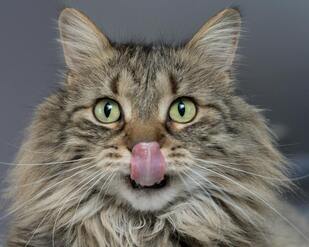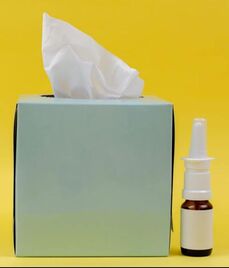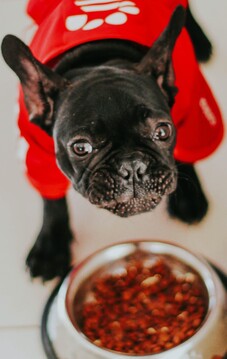Laurie Anne Walden, DVM Photo by Kadarius Seegars Photo by Kadarius Seegars Essential oils are compounds that give plants their scent and taste. They are volatile compounds, meaning that they evaporate quickly and release chemicals into the air. Essential oils are in many products: aromatherapy products, home fragrances, flavorings, personal care items (like shampoo), “natural” remedies, insect repellents, and so forth. Essential oils can sometimes be dangerous for pets, so be aware of the possible risks if you use these products. Whether an essential oil will cause a problem for an animal depends on the type of exposure, the concentration of oil, the animal’s individual risk factors, and the type of oil. The following essential oils are known to be toxic to cats and dogs, according to the Pet Poison Helpline.[1,2]
How Animals Are Exposed Essential oils enter the body through the skin, by swallowing, or by inhalation. Pets are most often exposed to toxic levels when owners apply an essential oil directly to the skin or fur in an attempt to treat a skin condition or repel fleas. The oil is absorbed into the body through the skin, and the animal is further exposed by licking oil from the fur. The risk increases with higher concentrations of essential oils. Products containing a high percentage of essential oil (approaching 100%) should never be applied directly to an animal’s skin or hair. Diffusers spread the fragrance of essential oils into a space. Passive diffusers work through evaporation: they send the scent of the oil, but not the oil itself, into the air. Passive diffusers are mainly a risk if a pet knocks one over and licks the oil or gets oil on the fur. Active diffusers (like nebulizers and ultrasonic diffusers) send actual particles of oil into the air. Oil from active diffusers can get onto an animal’s skin or be inhaled into the lungs, so the animal can have direct exposure to the oil without touching the diffuser. Strong odors from either type of diffuser can cause respiratory tract irritation. Animals at Risk Cats are at higher risk from essential oils than dogs are. Cats lack a liver enzyme that helps eliminate essential oils from the body. Cats and other animals that groom themselves are also more likely to swallow oil that’s collected on the fur. Animals with asthma or other respiratory problems are at higher risk than others from inhalation exposure from diffusers. Birds are very sensitive to respiratory irritants, so diffusers can also cause problems for them. Symptoms Depending on the type of oil and the amount of exposure, essential oil toxicity can cause vomiting, diarrhea, drooling, tremors, loss of balance, skin irritation, coughing, difficulty breathing, low heart rate, low body temperature, rear leg paralysis, and liver failure. Animals with symptoms of essential oil poisoning need veterinary care and might need to be hospitalized for intensive care. Using Essential Oils Safely Use essential oils with caution if you have pets. These tips can help keep your pets safe:
References 1. Benson K. Essential oils and cats. Pet Poison Helpline. Accessed June 4, 2022. https://www.petpoisonhelpline.com/blog/essential-oils-cats/ 2. Marshall J. Essential oils and dogs. Pet Poison Helpline. Accessed June 4, 2022. https://www.petpoisonhelpline.com/pet-safety-tips/essential-oils-dogs/ Photo by Kadarius Seegars on Unsplash Laurie Anne Walden, DVM Photo by Oscar Sutton Photo by Oscar Sutton The goals of first aid are to stabilize the animal for transport to a veterinary clinic, keep the animal’s injury from getting worse, and avoid harm to people handling the animal. First aid can save an animal’s life, but it does not replace care at a veterinary hospital. Keep a first aid kit for your pets. Have contact information for animal poison control and nearby veterinary emergency clinics on hand. If possible, call the emergency clinic before you arrive with your pet. Handling an injured animal
Bee stings/insect bites If you can see the stinger in the animal’s skin, carefully remove it. Swelling of the face or throat that causes difficulty breathing is a medical emergency. Contact a veterinarian before giving any medication. Bleeding For external bleeding from a skin wound, apply gentle pressure with a gauze pad or clean cloth for at least a couple of minutes, until the blood clots. Do not use a tourniquet unless blood is spurting from a wound and the animal’s life is in danger (tourniquets can cause serious damage). Burns For thermal or electrical burns, remove the source of heat or electricity and apply cool compresses with a wet cloth. For chemical burns, flush the area with a large volume of water. Do not apply butter, ointment, or ice to the burn; seek veterinary care instead. Choking Coughing and reverse sneezing can be mistaken for choking. If the animal is truly choking on something in the throat, do a finger sweep of the mouth (only if you can do so without being bitten) and remove the object if possible. Be careful not to push the object farther down. If the animal collapses because of choking, try the Heimlich maneuver: lay the animal on its side and strike the rib cage a few times with the flat of your hand. Fractures In most cases you won’t know if your pet really has a fracture until a veterinarian has taken radiographs. Minimize your pet’s movement as much as possible during transport. Don’t give pain medication unless a veterinarian has specifically recommended it. Don’t try to splint the limb; the splint might make things worse and you could be bitten in the attempt. Heat stroke Heat stroke can happen quickly, especially if an animal is left in a car in warm weather. First aid should not delay immediate transport to a veterinary clinic. If you can’t transport the pet right away, move the pet into a cooler, shaded area. Apply towels soaked in cool water or pour cool water over the animal’s body, especially the neck, armpits, belly, and groin (between the back legs). Don’t use ice. Not breathing, no heartbeat Unfortunately, most animals with cardiac arrest die, even if they receive cardiopulmonary resuscitation. If you try resuscitation, it’s best to do it on the way to the veterinary clinic while someone else drives (no delay in transport). The first step is to check inside the mouth for an object blocking the airway. Then hold the mouth closed and breathe into the animal’s nose until the chest expands. Breathe every 4 to 6 seconds, checking after every few breaths to see if the animal can breathe on its own. After you have begun rescue breaths and if the animal still has no heartbeat, begin chest compressions. Lay the animal on its right side, place one hand under the ribs, and place the other hand on top of the ribs at the widest part of the rib cage (just behind the elbow). Push down on the ribs at least 1 inch, more for large dogs. For cats and other very small animals, cup the chest in one hand and squeeze the ribs between the thumb and fingers. Apply 80 to 120 compressions per minute for large dogs and 100 to 150 compressions per minute for cats and small dogs. Every 4 to 6 seconds, stop the chest compressions and give a breath. Continue until you have arrived at the clinic or the animal’s heart is beating and the animal is breathing. Poisoning If you think your pet has eaten or been exposed to a dangerous substance, call a veterinary clinic or an animal poison control hotline. Note the time of exposure, the amount you think your pet swallowed or was exposed to, and the symptoms. Keep the packaging material, if available, so the ingredients can be identified. If your pet vomits, take a sample of the vomit to the veterinary facility in case it’s needed for analysis. Don’t give anything to induce vomiting unless a veterinarian or animal poison control specialist has specifically recommended it. Seizure If possible, time the seizure and note what the animal did before, during, and after the convulsions (for example, acting “spaced out,” paddling the legs, or urinating). Keep your hands away from the animal’s face and don’t try to hold the animal. Move objects that could hurt the animal out of the way. If the animal is having a seizure near stairs, the edge of a deck, or another drop, use a physical barrier to keep the animal from falling. Snakebite Snakebites can be very painful, so use a muzzle to protect yourself from being bitten by your pet. Take a photo of the snake if possible, but stay away from it! Don’t try to catch or kill the snake. Keep your pet as calm as you can while you travel to the veterinary clinic. Don’t apply a tourniquet or ice, and don’t try to draw venom out of the wound. For more information
Photo by Oscar Sutton on Unsplash Laurie Anne Walden, DVM Photo by Alvan Nee Photo by Alvan Nee Prepare for pet injuries and emergencies by collecting first aid supplies in advance. You can purchase a pet first aid kit or make your own. Some of the items in a family first aid kit can also be used for animals. Emergency clinic contact information Keep a list of phone numbers of emergency clinics in your area and at travel destinations. Include animal poison control phone numbers in your list. Emergency clinics can be very busy, so if possible have contact information for multiple clinics in case the nearest one has a long wait. Call the clinic before you arrive if your pet’s condition allows time for this. Vaccination records and medical history The most important vaccination record for an emergency clinic to have is the rabies vaccination. A list of current medications and medical conditions will also be helpful, especially if someone who is less familiar with your pet’s medical history (like a pet sitter) might be taking your pet for treatment. Your primary care veterinary clinic might be closed when your pet needs emergency treatment, so have written medical records available for the emergency service. Muzzle Animals in pain can bite even if they are friendly at other times. A muzzle will help you transport your dog safely. The best type of muzzle for a dog is a basket muzzle that allows the dog to pant. You can find inexpensive basket muzzles at pet stores and online. If you plan in advance, you can reduce your dog’s anxiety about using a muzzle during an emergency by training your dog to like wearing a muzzle. See the Muzzle Up Project for tips on muzzle training. (Short version: muzzles are treat baskets!) Don’t try to put a muzzle on a dog if you would be bitten in the attempt. Emergency muzzle alternatives include a leash, rope, necktie, or bandage material wrapped around the mouth. Items that hold the mouth completely closed should never cover the nostrils, should be used only for a very short time (just to get the animal into the car), and should not be used for animals that are vomiting. Another option is to cover the animal’s head with a towel or blanket, but take extra care—animals can bite through cloth, especially if they’re frightened or in pain. Leash or pet carrier A slip leash might be easier than a clip leash to put on a scared dog. For cats, consider keeping a hard plastic carrier with a top that can be removed. If you’ve picked up your cat with a towel, you can bundle both the cat and the towel into the bottom half of the carrier and then reattach the top half. Gauze sponges and nonstick pads Plain gauze squares are used to absorb blood and drainage but are uncomfortable if they stick to a wound. If you’re bandaging a wound, use a nonstick pad as the inner layer (touching the wound) and add layers of plain gauze over the nonstick pad as needed for absorption. Self-adherent bandage wrap (Vet Wrap or similar) Flexible self-adherent wrap is used as the outer layer of a bandage. This material bonds to itself but doesn’t stick to fur. It’s stretchy, so it can cut off circulation if it’s applied tightly. Don’t stretch it while you’re applying it; just lay it over the top of the gauze and press gently to adhere it to itself. Adhesive bandage tape If you have self-adherent wrap, you might not need adhesive bandage tape. Adhesive tape is used to hold a bandage together. For a first aid bandage, try to avoid sticking tape to the fur. If a pet needs a bandage that’s more secure than just self-adherent wrap over gauze, the pet needs to be seen at a veterinary clinic and someone there will be taking your bandage off anyway. Don’t use Band-Aids or other adhesive bandages meant for humans. Bandage scissors Antibacterial ointment Tweezers (for removing ticks) Disposable gloves Eye wash Eye wash or sterile saline is good to have on hand if a potentially damaging liquid gets splashed into an animal’s eyes. Use care when working around an injured animal’s face, though. Towels Towels are handy for mopping up messes, creating an impromptu stretcher, or soaking in water to cool an overheated animal. Medications and other remedies Medications like pain relievers and antihistamines should only be used if a veterinarian has specifically recommended them. Many pain relievers for humans, including common nonprescription pain relievers, are not safe for pets. Some pet first aid supply lists include products to induce vomiting or poison remedies like activated charcoal. Never use products like these without consulting a veterinarian first. Inducing vomiting can be harmful. For example, caustic substances and foreign objects can damage the esophagus on the way down and again on the way back up. Photo by Alvan Nee on Unsplash Laurie Anne Walden, DVM Phalaenopsis orchid: not toxic to dogs or cats. Public domain photo by Bob Burch. Phalaenopsis orchid: not toxic to dogs or cats. Public domain photo by Bob Burch. Before bringing a plant into your home, be sure it’s safe for your pets. Some plants are so toxic they should never be kept in homes where animals live (the most hazardous are sago palms and, for cats, lilies). But many plants pose little danger to animals and are good choices for households with pets. If you need to find out if a plant is safe, the list of toxic and nontoxic plants on the ASPCA Animal Poison Control website is an excellent resource: https://www.aspca.org/pet-care/animal-poison-control/toxic-and-non-toxic-plants. You can search the list for specific plants, and you can also generate lists of plants that are toxic or not toxic for dogs, cats, or horses. Some toxic and nontoxic plants have very similar common names, so always check a plant’s scientific name. “Toxic” is a relative term when it comes to plants. Plants listed as toxic might cause anything from mild mouth irritation to death. Even plants listed as nontoxic can cause nausea, vomiting, or diarrhea if they’re eaten. Plants listed as nontoxic should not cause life-threatening illness in animals. These are a few of the houseplants that are not toxic to dogs and cats, according to ASPCA Animal Poison Control. Scientific names are from the ASPCA and the North Carolina Extension Gardener Plant Toolbox (https://plants.ces.ncsu.edu/). African violet (Streptocarpus ionanthus) American or baby rubber plant (Peperomia obtusifolia) Always check the scientific names of plants called “rubber.” Baby rubber plants aren’t toxic to dogs and cats. Jade plants, sometimes called dwarf rubber or Chinese rubber plants (Crassula ovata), are toxic. Indian rubber plants (Ficus benjamina) are also toxic to dogs and cats. Boston fern (Nephrolepis exalta) Some ferns are safe and some aren’t. Boston fern isn’t toxic to dogs and cats, but asparagus fern (Asparagus densiflorus [Sprengeri group]) and some of the ferns that grow outdoors are. Fern palm is another name for sago palm (Cycas and Zamia species), one of the most dangerous plants to have anywhere near an animal. Cast iron plant (Aspidistra elatior) Christmas cactus (Schlumbergera species) Christmas cactus isn’t toxic, but pencil cactus (Euphorbia tirucalli) irritates the mouth and stomach and can cause vomiting. Gerbera daisy (Gerbera jamesonii) Gerbera daisies are safe for dogs and cats. Some other daisy-like plants are listed as toxic; these include seaside daisy (Erigeron speciosus), chrysanthemum (Chrysanthemum species), chamomile (Chamaemelum nobile), and, not surprisingly, poison daisy/mayweed (Eclipta prostrata). Hens and chicks (Sempervivum species) The small succulent called hens and chicks isn’t toxic. Some other succulents, like jade plants (Crassula species), can be toxic to dogs and cats. Majesty palm (Ravenea rivularis), parlor palm (Chamaedorea elegans) Always look up palm species to be sure they’re safe. Majesty, parlor, and several other types of palm are safe for dogs and cats, but sago palm (Cycas and Zamia species) can be deadly. Phalaenopsis or moth orchid (Phalaenopsis species) Spider or ribbon plant (Chlorophytum comosum) Zebra haworthia (Haworthiopsis species) The zebra plant looks similar to aloe (Aloe vera) but is safer for dogs and cats. Aloe can cause vomiting and diarrhea. Public domain photo of Phalaenopsis or moth orchids by Bob Burch on Flickr Laurie Anne Walden, DVM Photo by Lina Angelov Photo by Lina Angelov Human medications that are applied to the skin can be dangerous for pets. Even tiny amounts of some topical drug preparations are toxic to dogs and cats. Animals are exposed to topical medications by chewing a product tube, licking the product from a person’s skin, licking their fur after being touched by someone with the product on their hands, or possibly by absorbing the medication through their own skin. If you use any topical medications, be aware of the possible risk to animals. Keep all medications out of your pets’ reach. Wash the product off your hands or wear gloves while applying it, and keep pets from licking skin and bedding that the product has touched. If you think your pet has been exposed to a toxin, contact your veterinarian or animal poison control:
Calcipotriene, Calcitriol Calcipotriene and calcitriol are forms of vitamin D used to treat psoriasis. Animals that swallow topical preparations can develop abnormally high calcium levels and potentially life-threatening kidney damage. Symptoms include loss of appetite, vomiting, and increased urine volume. Corticosteroids Topical corticosteroids like betamethasone, clobetasol, hydrocortisone, and triamcinolone are used to treat various skin conditions. In animals, exposure can lead to a wide range of symptoms including increased urine volume, increased thirst, vomiting, and skin changes. Estradiol Animals exposed to topical hormone products containing estradiol and other forms of estrogen can develop hair loss, anemia, or low levels of platelets and white blood cells.[1] Fluorouracil Fluorouracil cream is used to treat certain skin cancers. The US Food and Drug Administration (FDA) reports that 5 dogs have died after ingesting small amounts of fluorouracil; 1 of the dogs died after simply puncturing the tube with its teeth.[2] Symptoms in cats and dogs include vomiting, loss of balance, and seizures. Minoxidil The hair loss treatment minoxidil (Rogaine) can cause severe heart problems in animals exposed to small amounts. At least 8 cats have died after their owners used topical minoxidil. Other cats and dogs have become seriously ill.[3] Pain Relievers: Local Anesthetics Local anesthetics like benzocaine, lidocaine, and tetracaine (ingredients ending in ‑caine) are often included in over-the-counter products to treat pain from sunburn, insect bites, and so forth. If swallowed, these drugs can cause seizures and abnormal heart rhythm.[1] Pain Relievers: Nonsteroidal Anti-inflammatory Drugs Flurbiprofen and diclofenac are among the many nonsteroidal anti-inflammatory drugs (NSAIDs) commonly used to treat pain. Some veterinary NSAIDs are safe to use in dogs, but most human NSAIDs are dangerous for animals, especially cats. The FDA has warned that topical flurbiprofen can cause serious illness or death in pets that are exposed to the product on a person’s skin.[4] Many over-the-counter topical pain relievers contain NSAIDs, so read product labels carefully. Retinoids Retinoids like adapalene and tretinoin are used to treat acne and skin disorders and are included in some wrinkle remedies. Exposure can lead to liver damage in animals.[1] Zinc Oxide Zinc oxide is a common ingredient in over-the-counter sunscreens, diaper rash creams, and other products. Animals can vomit and have diarrhea after swallowing zinc oxide.[5] References 1. Tater KC, Gwaltney-Brant S, Wismer T. Dermatological topical products used in the US population and their toxicity to dogs and cats. Vet Dermatol. 2019;30(6):474-e140. doi:10.1111/vde.12796 2. FDA advice on pet exposure to prescription topical (human) cancer treatment: fluorouracil. US Food and Drug Administration. November 2, 2020. Accessed October 22, 2021. https://www.fda.gov/animal-veterinary/animal-health-literacy/fda-advice-pet-exposure-prescription-topical-human-cancer-treatment-fluorouracil 3. Tater KC, Gwaltney-Brant S, Wismer T. Topical minoxidil exposures and toxicoses in dogs and cats: 211 cases (2001-2019). J Am Anim Hosp Assoc. 2021;57(5):225-231. doi:10.5326/JAAHA-MS-7154 4. FDA consumer advice on pet exposure to prescription topical pain medications containing flurbiprofen. US Food and Drug Administration. October 1, 2019. Accessed October 22, 2021. https://www.fda.gov/animal-veterinary/animal-health-literacy/fda-consumer-advice-pet-exposure-prescription-topical-pain-medications-containing-flurbiprofen 5. Khan SA. Topical preparations (toxicity). Merck Veterinary Manual. August 2014. Accessed October 22, 2021. https://www.merckvetmanual.com/toxicology/toxicities-from-human-drugs/topical-preparations-toxicity Photo by Lina Angelov on Unsplash Laurie Anne Walden, DVM  Yulia Khlebnikova via Unsplash Yulia Khlebnikova via Unsplash Chip, snack, and cereal bags pose a suffocation risk that pet owners might not know about until it’s too late. Dogs and cats have died after putting their heads in snack bags and other food containers. Of the various types of food containers, plastic and Mylar-lined bags are the biggest suffocation hazards. When an animal with its head in a bag inhales, the bag tightens around the head, cutting off airflow. The animal might not be able to remove the bag on its own. Death can occur in just a few minutes. Preventive Vet conducted an online survey about pet suffocation and received 1354 responses from 2014 through 2018. The responses from pet owners whose pets died or almost died of suffocation are summarized here. Most common culprits:
Where pets got hold of the bags:
More than one-third of pet owners were home when their pet suffocated. Of the owners who were away from home, 18% were gone for less than 15 minutes. Animals of all sizes are at risk. According to the survey responses, more than half of the dogs who suffocated were larger than 30 lb, and some were over 60 lb. Prevention Simply being aware of the risk is a big part of keeping your pets safe. A lot of us have probably left chip and other food bags where our pets can reach them. Here are some steps you can take:
More Information Pet suffocation awareness, Preventive Vet website: https://www.preventivevet.com/pet-suffocation Prevent Pet Suffocation website: https://preventpetsuffocation.com/ Photo by Yulia Khlebnikova Laurie Anne Walden, DVM  Over-the-counter (nonprescription) nasal sprays and eye drops can pose a serious risk to animals that ingest them. The problem ingredients—imidazoline decongestants, phenylephrine, and xylitol—are common in products to treat allergies, colds, flu, and red eyes. If your pet chews a nasal spray or eye drop bottle, call your veterinarian or an animal poison control hotline immediately. This type of poisoning is a medical emergency. Even small amounts of ingested product can be dangerous. Pet poison hotlines (consultation fees apply):
Imidazoline Decongestants Decongestants in the imidazoline class are found in many nasal sprays and eye drops that reduce nasal congestion and eye redness. Some of the drugs in this group are oxymetazoline, naphazoline, tetrahydrozoline, tolazoline, and xylometazoline. A few of the many brands that contain imidazolines are Afrin, Clear Eyes, Mucinex, Opcon, Privine, Sinex, Visine, and Zicam. Imidazolines affect the heart, circulation, digestive system, and nervous system. They decrease nasal congestion and eye redness by narrowing small blood vessels in the nose and eyes. Symptoms of imidazoline poisoning appear as soon as 15 minutes after ingestion of a large amount or a few hours after ingestion of a small amount. The symptoms last from about 12 to 36 hours and include the following:
Animals with imidazoline poisoning need to be hospitalized for treatment and monitoring. Reversal agents for imidazolines are available. Phenylephrine Imidazolines and phenylephrine have similar effects on the body. Like imidazolines, phenylephrine acts as a decongestant by shrinking small blood vessels in the nose. Phenylephrine is available in oral forms, nasal sprays, eye drops, and hemorrhoid creams. Two brands of nasal spray that contain phenylephrine are Little Remedies and Neo-Synephrine. Ingestion can cause vomiting, agitation, hyperactivity, and increased blood pressure.[2] Xylitol Some nasal sprays, including some with labels reading “natural saline,” contain xylitol. One example is Xlear nasal spray. Xylitol is harmless in humans, but in dogs it causes a dangerous, rapid drop in blood sugar and can also cause liver damage. The best approach is to keep all remedies (prescription, nonprescription, and “natural”) out of reach of pets and never assume that a product that’s safe for children is also safe for animals. References 1. Almgren C. Clear eyes, dry nose, no problem? Wrong! Intoxications due to eye drops and nasal sprays. Pet Poison Helpline webinar. November 14, 2017. Accessed March 21, 2021. https://www.petpoisonhelpline.com/webinar/november-2017-intoxications-due-eye-drops-nasal-sprays/ 2. Khan SA. Decongestants (toxicity). Merck Veterinary Manual. Updated August 2014. Accessed March 21, 2021. https://www.merckvetmanual.com/toxicology/toxicities-from-human-drugs/decongestants-toxicity Photo by Diana Polekhina Laurie Anne Walden, DVM  Some bugs carry dangerous diseases or have venomous stings. But what about insects that our pets catch and swallow? Most are harmless, but a few are unsafe for pets. As warm weather arrives, keep an eye out for insects that can cause trouble if they’re eaten. Pesticides and insecticides can also be toxic to pets. Keep these products out of your pets’ reach and use them only according to the manufacturer’s instructions. Dogs and cats are most likely to get a toxic dose if they’re sprayed with the product or eat a significant amount. A pet that eats a single pesticide-covered insect would ingest a little bit of the product, but the amount would probably be too small to cause a problem (call your veterinarian if you’re unsure or if your pet shows any symptoms). Caterpillars Caterpillar hairs can be irritating to the touch, and some types of hairs release a toxin. Fur typically protects dogs’ and cats’ skin from the stings of caterpillar hairs. If a pet eats a caterpillar, though, the hairs can irritate the mouth and throat. Symptoms include drooling, pawing at the mouth, shaking the head, vomiting, and trouble swallowing. Processionary caterpillars (found in Europe, North Africa, and Asia) produce a toxin that causes an especially severe reaction.[1,2] Fireflies Fireflies are highly toxic to lizards, amphibians, and birds. Ingestion of a single firefly can kill a bearded dragon. Fireflies contain lucibufagins, which are chemicals that cause heart damage in susceptible species.[3] Asian Lady Beetles Asian lady beetles (Harmonia axyridis) look a lot like ladybugs, but unlike ladybugs they gather in large numbers and come inside houses in cold weather. As a defense mechanism, they secrete an irritating chemical compound. One published report describes a dog with oral trauma similar to chemical burns caused by 16 Asian lady beetles stuck to the roof of the mouth.[4] Blister Beetles Blister beetles (family Meloidae) produce a toxin called cantharidin, an irritant that causes blistering on contact with the skin, mouth, or digestive tract. Cantharidin poisoning is most common in horses that eat alfalfa hay contaminated with blister beetles. Exposure can be fatal to horses. Other species, including dogs, cats, rabbits, and people, are also susceptible to cantharidin poisoning.[5] Walking Sticks The insects known as walking sticks (order Phasmatodea) use camouflage as their main defense mechanism, but some of them also secrete a chemical that can burn the eyes or mouth. Anisomorpha buprestoides, a stick insect found in the southern United States, can aim this secretion directly at the face of a predator. Severe eye damage has been reported in humans and a dog.[6] Bombardier Beetles Brachinus beetles are called bombardier beetles because they secrete a toxic chemical that they aim at predators in what is usually described as “explosive discharge.” This chemical irritant is released at a boiling temperature.[7] Although I did not find any research reports of bombardier beetle poisoning in dogs or cats, I can’t imagine that eating one would be a comfortable experience. References 1. Bad bugs, bad bugs: what you should do to keep your pets safe. ASPCA. August 1, 2018. Accessed March 5, 2021. https://www.aspca.org/news/bad-bugs-bad-bugs-what-you-should-do-keep-your-pets-safe 2. Fuzzy green poisoners: caterpillar toxicosis in pets. ASPCA Pro. Accessed March 5, 2021. https://www.aspcapro.org/resource/fuzzy-green-poisoners-caterpillar-toxicosis-pets 3. Treating firefly toxicosis in lizards. ASPCA Pro. Accessed March 5, 2021. https://www.aspcapro.org/resource/treating-firefly-toxicosis-lizards 4. Stocks IC, Lindsey DE. Acute corrosion of the oral mucosa in a dog due to ingestion of multicolored Asian lady beetles (Harmonia axyridis: Coccinellidae). Toxicon. 2008;52(2):389-391. doi:10.1016/j.toxicon.2008.05.010 5. Schmitz DG. Overview of cantharidin poisoning. Merck Veterinary Manual. Updated June 2013. Accessed March 5, 2021. https://www.merckvetmanual.com/toxicology/cantharidin-poisoning/overview-of-cantharidin-poisoning 6. Thomas MC. Featured creatures: twostriped walkingstick. University of Florida Entomology & Nematology. Publication No. EENY-314. November 2003. Accessed March 5, 2021. http://entnemdept.ufl.edu/creatures/misc/walkingstick.htm 7. Schaller JC, Davidowitz G, Papaj DR, Smith RL, Carrière Y, Moore W. Molecular phylogeny, ecology and multispecies aggregation behaviour of bombardier beetles in Arizona. PLoS One. 2018;13(10):e0205192. doi:10.1371/journal.pone.0205192 Photo by Kazuky Akayashi Laurie Anne Walden, DVM  On January 11, 2021, the US Food and Drug Administration (FDA) issued an alert about certain Sportmix pet foods recalled because of high levels of aflatoxin. At the time of the alert, 70 dogs had died and more than 80 were sick (not all of them officially confirmed as having aflatoxin poisoning).[1] Other pet foods have been recalled in the past because of aflatoxin. For a list of foods included in the current recall, see the FDA alert: https://www.fda.gov/animal-veterinary/outbreaks-and-advisories/fda-alert-certain-lots-sportmix-pet-food-recalled-potentially-fatal-levels-aflatoxin Cause Aflatoxins are produced by molds (Aspergillus species) that grow on grains like corn. Animals are exposed by eating contaminated animal diets or moldy corn, peanuts, or other foods. Food doesn’t have to look moldy to be contaminated with aflatoxins. Because commercial dog food is typically the main component of a dog’s diet and dogs usually eat from a single bag of food until it’s finished, even low levels of aflatoxin in the food can accumulate in the body and cause symptoms.[2] Symptoms The liver is the main organ affected. Liver damage causes nonspecific digestive tract symptoms. Severe liver damage reduces the ability of the blood to clot and can lead to central nervous system problems. Death occurs quickly in some animals with aflatoxin poisoning. Symptoms include the following:
Diagnosis The symptoms of aflatoxin poisoning aren’t specific and could have a number of causes. Diagnosis begins with history, physical examination, and blood and urine tests. If test results show liver damage and a toxin is suspected, the next step is obtaining a complete history of everything the animal has been exposed to, including all foods and treats. Food samples and possibly tissue samples from the body can be sent to a laboratory to test for aflatoxin. Treatment Treatment consists of supportive care and management of problems (like blood clotting disorders) caused by liver failure. Specific treatment depends on the individual patient’s needs. What You Should Do The FDA recommends that pet owners take these steps:
See this FDA page for information about reporting possible problems with pet food: https://www.fda.gov/animal-veterinary/report-problem/how-report-pet-food-complaint Watch for pet food recall alerts in the news and on social media. The FDA posts recalls on the FDA Recalls Twitter account: https://twitter.com/FDArecalls References 1. FDA alert: certain lots of Sportmix pet food recalled for potentially fatal levels of aflatoxin. US Food and Drug Administration. Updated January 11, 2021. Accessed January 22, 2021. https://www.fda.gov/animal-veterinary/outbreaks-and-advisories/fda-alert-certain-lots-sportmix-pet-food-recalled-potentially-fatal-levels-aflatoxin 2. Martínez-Martínez L, Valdivia-Flores AG, Guerrero-Barrera AL, Quezada-Tristán T, Rangel-Muñoz EJ, Ortiz-Martínez R. Toxic effect of aflatoxins in dogs fed contaminated commercial dry feed: a review. Toxins (Basel). 2021;13(1):E65. doi:10.3390/toxins13010065 3. Aflatoxin poisoning in pets. US Food and Drug Administration. Updated January 8, 2021. Accessed January 22, 2021. https://www.fda.gov/animal-veterinary/animal-health-literacy/aflatoxin-poisoning-pets Photo by Jornada Produtora Laurie Anne Walden, DVM  Many over-the-counter (nonprescription) cold and flu medications contain ingredients that are toxic to dogs and cats. Keep all medications out of reach of your pets, and check with your veterinarian before giving a pet any medication—even remedies that are safe for children. Cold medications are often sold as combination or multisymptom products containing more than 1 active ingredient. If your veterinarian recommends giving your pet a nonprescription medication, read the product label carefully to be sure it contains only the medication your veterinarian has approved. Ingestion of some cold and flu products (especially oral decongestants, nasal sprays, eye drops, and pain relievers) is a medical emergency in animals. If your pet is exposed, contact a veterinary clinic or pet poison hotline:
Oral Decongestants Decongestants are often added to allergy medications and combination cold and cough remedies. If your veterinarian has recommended a nonprescription antihistamine for your pet, be sure that the product you use does not contain a decongestant. Look for label wording like congestion, stuffy nose, runny nose, multisymptom, or sinus pressure; these probably mean that the product includes a decongestant. Names of products containing decongestants might end in D (for example, Claritin-D and Mucinex D) or PE (as in Sudafed PE). Pseudoephedrine and phenylephrine are the most common oral (by-mouth) decongestants. Both are dangerous for animals. In the United States, pseudoephedrine is sold without a prescription but with restrictions: it’s sold only in limited quantities, is usually kept behind the pharmacy counter or in a locked cabinet, and requires that the buyer show identification. If you’re not sure of the ingredients of your cold medication, knowing whether you took it from an open shelf or had to ask the pharmacist for it will help you figure out whether it is likely to contain pseudoephedrine. Pseudoephedrine stimulates the cardiovascular system and certain nervous system pathways. It reduces nasal congestion by shrinking tiny blood vessels in the nose. It has a very narrow margin of safety in animals, meaning that a small dose can have serious consequences for a dog or cat. Symptoms of pseudoephedrine toxicity include the following:
The time of symptom onset depends on the formulation. With immediate-release products, symptoms can begin within minutes of ingestion. With extended-release products, symptoms might not appear for several hours.[1] Phenylephrine is an ingredient in oral cold remedies, hemorrhoid creams, nasal sprays, and some eye drops. Animals are exposed by swallowing the product. The most common symptom is vomiting; other symptoms are similar to those of pseudoephedrine toxicity. Phenylephrine is not as toxic as pseudoephedrine at low doses.[2] Nasal Sprays and Eye Drops Oxymetazoline, tetrahydrozoline, naphazoline, and xylometazoline are imidazolines, a class of decongestant used in nasal sprays and eye drops (examples are Afrin and Visine). Animals—usually dogs—who chew the bottle and ingest the liquid can develop vomiting, lethargy, incoordination, slow heart rate, tremors, and coma. Imidazoline ingestion can be fatal.[3] Some nasal sprays contain xylitol, a sweetener that is safe for humans but toxic to pets. Plain saline nasal rinses with no ingredients other than water and salt should be safe if accidentally ingested, but don’t squirt them up your pet’s nose. Pain Relievers Combination cold and flu products commonly contain pain relievers, most of which are unsafe for dogs and cats. Acetaminophen is extremely toxic to cats even at low doses. It causes liver failure, damage to hemoglobin in red blood cells, and death. It can also cause liver damage in dogs. Ibuprofen and naproxen are in a class of pain relievers called nonsteroidal anti-inflammatory drugs. In dogs and cats, these medications can cause stomach ulcers, digestive tract bleeding, kidney damage, and liver damage. Cough Suppressants and Cough Drops Dextromethorphan is an antitussive, or cough suppressant, included in many cough remedies and combination cold and flu products. Animals who ingest dextromethorphan can develop vomiting, lethargy, rapid heart rate, and seizures.[4] Potentially toxic ingredients in cough drops include xylitol, which causes a dangerous drop in blood sugar in dogs, and benzocaine, which can cause upset stomach and possibly damage to red blood cells. “Natural” Remedies In high enough doses, zinc can damage red blood cells. Essential oils like menthol, camphor, and eucalyptus oil can cause skin reactions if applied topically. If swallowed or absorbed through the skin, these oils can cause symptoms ranging from vomiting to nervous system problems. References 1. Pseudoephedrine toxicity in pets. ASPCApro. Accessed January 9, 2021. https://www.aspcapro.org/resource/pseudoephedrine-toxicity-pets 2. Wegenast C. Toxicology brief: phenylephrine ingestion in dogs: what's the harm? DVM360. November 1, 2012. Accessed January 9, 2021. https://www.dvm360.com/view/toxicology-brief-phenylephrine-ingestion-dogs-whats-harm 3. Imidazoline. Pet Poison Helpline. Accessed January 9, 2021. https://www.petpoisonhelpline.com/poison/imidazoline/ 4. Dextromethorphan ingestion in pets. ASPCApro. Accessed January 9, 2021. https://www.aspcapro.org/resource/dextromethorphan-ingestion-pets Photo by Shlomi Platzman |
AuthorLaurie Anne Walden, DVM Categories
All
Archives
May 2024
The contents of this blog are for information only and should not substitute for advice from a veterinarian who has examined the animal. All blog content is copyrighted by Mallard Creek Animal Hospital and may not be copied, reproduced, transmitted, or distributed without permission.
|
- Home
- About
- Our Services
- Our Team
-
Client Education Center
- AKC: Spaying and Neutering your Puppy
- Animal Poison Control
- ASPCA Poisonous Plants
- AVMA: Spaying and Neutering your pet
- Biting Puppies
- Boarding Your Dog
- Caring for the Senior Cat
- Cats and Claws
- FDA warning - Bone treats
- Force Free Alliance of Charlotte Trainers
- Getting your Cat to the Vet - AAFP
- Holiday Hazards
- How To Feed Cats for Good Health
- How to Get the Most Out of your Annual Exam
- Indoor Cat Initiative - OSU
- Introducing Your Dog to Your Baby
- Moving Your Cat to a New Home
- Muzzle Training
- Osteoarthritis Checklist for Cats
- What To Do When You Find a Stray
- Our Online Store
- Dr. Walden's Blog
- Client Center
- Contact
- Christmas Party 2023
|
Office Hours
Monday through Friday 7:30 am to 6:00 pm
|
|
Site powered by Weebly. Managed by IDEXX Laboratories

 RSS Feed
RSS Feed

